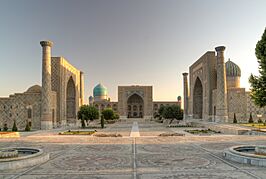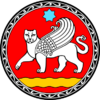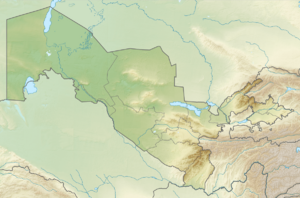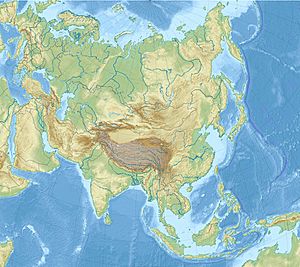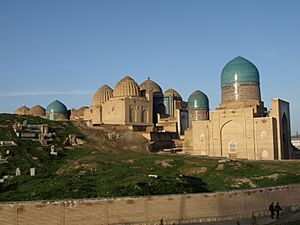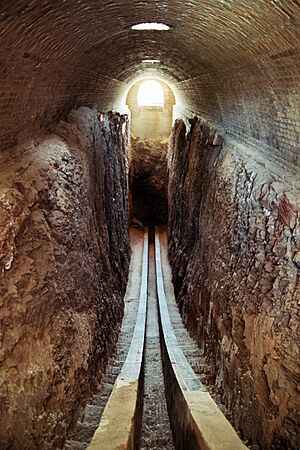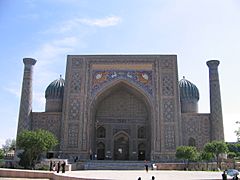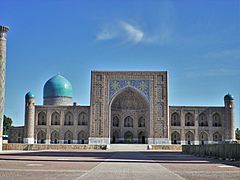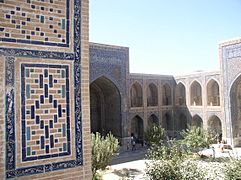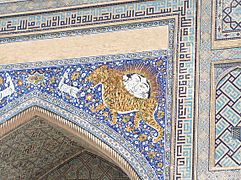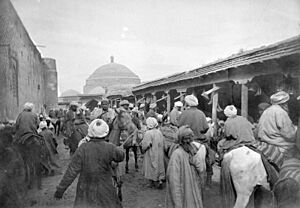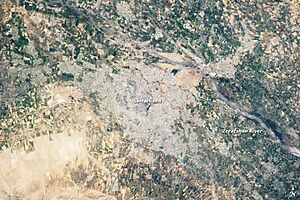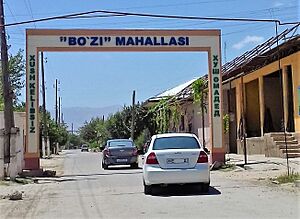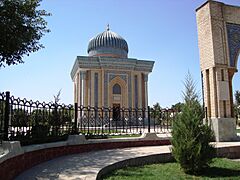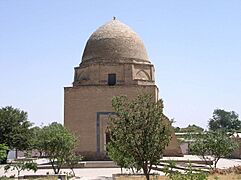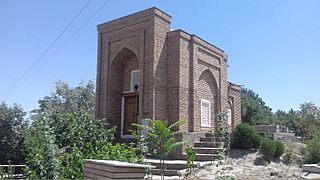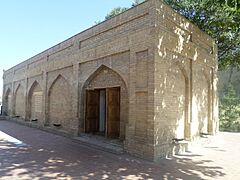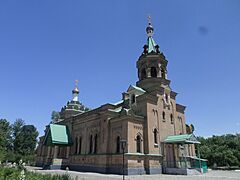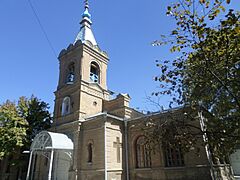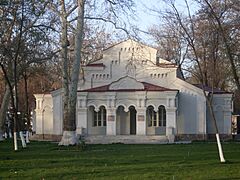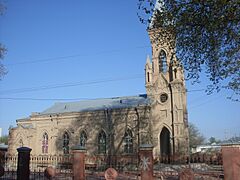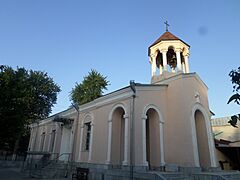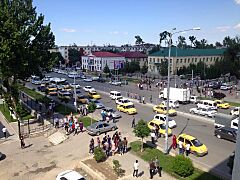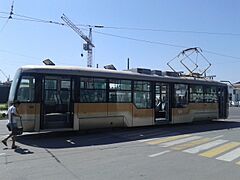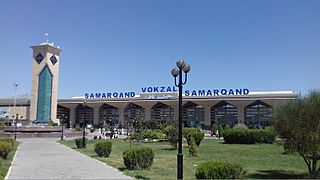Samarkand facts for kids
Quick facts for kids
Samarkand
Самарканд
|
|||||||||||||||||
|---|---|---|---|---|---|---|---|---|---|---|---|---|---|---|---|---|---|
|
City
|
|||||||||||||||||
|
|||||||||||||||||
| Country | |||||||||||||||||
| Vilayat | Samarqand Vilayat | ||||||||||||||||
| Settled | 8th century BCE | ||||||||||||||||
| Government | |||||||||||||||||
| • Type | City Administration | ||||||||||||||||
| • Body | Hakim (Mayor) | ||||||||||||||||
| Area | |||||||||||||||||
| • City | 120 km2 (50 sq mi) | ||||||||||||||||
| Elevation | 705 m (2,313 ft) | ||||||||||||||||
| Population
(1 January 2019)
|
|||||||||||||||||
| • City | 513,572 | ||||||||||||||||
| • Density | 4,280/km2 (11,100/sq mi) | ||||||||||||||||
| • Metro | 950,000 | ||||||||||||||||
| Demonym(s) | Samarkandian / Samarkandi | ||||||||||||||||
| Time zone | UTC+5 | ||||||||||||||||
| Postal code |
140100
|
||||||||||||||||
|
|||||||||||||||||
Samarkand is a famous city in southeastern Uzbekistan. It is one of the oldest cities in Central Asia where people have lived without interruption for thousands of years. Samarkand is the capital of the Samarqand Region and the third-largest city in Uzbekistan, with over 550,000 people in 2021.
People have lived in the Samarkand area since the late Paleolithic Era, which was a very long time ago! While we don't know the exact founding date, many experts believe it was built between the 8th and 7th centuries BCE. Samarkand became very important because it was located on the Silk Road. This ancient trade route connected China, Persia, and Europe. Because of its location, Samarkand was often one of the biggest cities in Central Asia.
The city was conquered by Alexander the Great in 329 BCE. Back then, it was called Markanda. Later, in the 14th century, Timur (also known as Tamerlane) made Samarkand the capital of his huge empire. He also built his tomb, the Gur-e Amir, there. The Bibi-Khanym Mosque and Registan square are some of the city's most famous landmarks.
Samarkand is also known for its traditional crafts. These include beautiful embroidery, goldwork, silk weaving, and ceramics. In 2001, UNESCO recognized the city's importance by adding it to its World Heritage List. It's called Samarkand – Crossroads of Cultures.
Today, Samarkand has two main parts: the old city and the new city. The old city is where you'll find historical buildings, shops, and old houses. The new city has modern buildings, cultural centers, and schools.
Contents
What's in a Name?
The name Samarkand comes from old Iranian languages like Persian and Sogdian. Samar means "stone" or "rock," and kand means "fort" or "town." So, Samarkand means "Stone Fort" or "Stone Town."
Interestingly, the capital of Uzbekistan, Tashkent, has a similar meaning. Tash- is a Turkic word for "stone," and -kent is a Turkic word for "town," borrowed from Iranian languages.
Some old scholars also had different ideas about the name. An 11th-century scholar, Mahmud al-Kashgari, said the city was called Sämizkänd in an old Turkic language, which meant "fat city."
A Look at Samarkand's History
Samarkand is one of the oldest cities in Central Asia where people have lived continuously. It grew rich because of its important spot on the Silk Road, connecting China and Europe.
Early Beginnings
Archaeologists have found signs of human activity in Samarkand dating back 40,000 years! This means people lived here even in the Upper Paleolithic period. The city's water canals, Syob and Darg'om, were built around the 7th–5th centuries BCE.
From its earliest days, Samarkand was a major center for the Sogdian people. It even became the capital of the Sogdian region under the Achaemenid Empire of Persia.
Alexander the Great's Arrival
Alexander the Great conquered Samarkand in 329 BCE. The Greeks called the city Maracanda. Even though the city was damaged during Alexander's takeover, it quickly recovered. New building methods, like using square bricks, were introduced.
Alexander's conquests brought classical Greek culture to Central Asia. Greek art and ideas influenced local artists for a while. Samarkand was then ruled by different groups, including the Seleucid Empire, Greco-Bactrian Kingdom, and Kushan Empire.
Changes Over Time
Around 260 AD, the Persian Sassanians took over Samarkand. This made the region important for the Manichaeism religion, helping it spread across Central Asia.
Later, between 350 and 375 AD, nomadic tribes called Xionites conquered Samarkand. Then, the Hephtalites (also known as "White Huns") controlled the city until the Göktürks and Persians defeated them around 560 CE.
In the early Middle Ages, Samarkand was well-protected with four layers of defensive walls and four gates.
The Coming of Islam

The armies of the Umayyad Caliphate captured Samarkand around 710 CE. Before this, Samarkand was home to many religions, including Zoroastrianism, Buddhism, and Judaism. Most people followed Zoroastrianism.
The Arab conquerors built a mosque in Samarkand, and many people in the city became Muslim. Samarkand then grew into a center for Islamic learning.
A famous story says that during the Abbasid rule, the secret of papermaking came to Samarkand from two Chinese prisoners in 751. This led to the first paper mill in the Islamic world being built in Samarkand. From there, paper-making spread to other parts of the Islamic world and eventually to Europe!
Later, the Samanids ruled Samarkand (875–999), making it their capital and an even more important trade hub.
Karakhanid Period
After the Samanids, the Turkic Qarakhanid dynasty took over. Samarkand became their capital from 1040 to 1212. During this time, a public hospital and a madrasah (a type of school) were built. The beautiful Shah-i-Zinda memorial complex was also started by the Qarakhanid rulers in the 11th century.
Mongol Invasion
In 1220, the Mongols led by Genghis Khan conquered Samarkand. The city suffered a lot of damage. However, it remained part of the Chagatai Khanate until 1370.
Marco Polo, a famous traveler, described Samarkand in the late 1200s as "a very large and splendid city."
Timur's Golden Age
In 1370, the great conqueror Timur (also known as Tamerlane) made Samarkand the capital of his empire. For the next 35 years, he rebuilt most of the city. He brought in the best artists and craftsmen from all over his empire to make Samarkand beautiful. Timur was known for being very kind to artists, even if he was tough on his enemies. He wanted Samarkand to be the most amazing city.
Timur was very involved in building projects. He often ordered buildings to be finished quickly or redone if he wasn't happy. The city was always under construction! At this time, Samarkand had about 150,000 people.
Ulugh Beg's Era of Science
Between 1417 and 1420, Timur's grandson, Ulugh Beg, built a madrasah in Samarkand. This school became the first building in the famous Registan square. Ulugh Beg invited many top astronomers and mathematicians to this madrasah.
Under Ulugh Beg, Samarkand became a world center for science, especially astronomy. He built an amazing observatory in 1428. Its main tool was a giant wall quadrant, which was unique in the world. It helped scientists measure the positions of stars and planets.
Later Centuries
In 1500, nomadic Uzbek warriors took control of Samarkand. The city became part of the new “Bukhara Khanate.” The ruler, Muhammad Shaybani Khan, built a large madrasah in Samarkand.
Later, in the 17th century, more famous buildings were added to Samarkand. The governor, Yalangtush Bahadur, built the Tillya-Kari madrasah and Sherdor madrasah, which are still stunning today.
-
Tiger on the Sher-Dor Madrasah iwan
After being attacked in the early 1720s, the city was left empty for a while. It started to revive in the mid-1700s.
Russian Empire Period
In 1868, the city came under imperial Russian rule. A new Russian part of the city was built west of the old city. In 1886, Samarkand became the capital of the new Samarkand Oblast. It became even more important when the Trans-Caspian railway reached it in 1888.
Soviet Era

Samarkand was the capital of the Uzbek SSR (Soviet Socialist Republic) from 1925 to 1930. During World War II, many people from Samarkand went to fight. Thousands of refugees from western parts of the Soviet Union also came to the city for safety.
In 1970, Samarkand celebrated its 2500th anniversary. A museum about the city's history was opened, and a monument to Ulugh Beg was built.
Samarkand's Location
Samarkand is in southeastern Uzbekistan, in the Zarefshan River valley. It's about 135 km from Qarshi and 270 km from Tashkent, the current capital of Uzbekistan. The border with Tajikistan is only about 35 km away.
Weather in Samarkand
Samarkand has a cold semi-arid climate. This means it has hot, dry summers and winters that can be cold and wet. July and August are the hottest months, with temperatures sometimes going above 40°C (104°F). It doesn't rain much from June to October.
People of Samarkand
Samarkand is a city with many different cultures and languages. While official reports say most people are Uzbeks, many sources suggest that a large number, up to 70%, are Tajiks. Tajiks are especially found in the eastern part of the city, where many historical buildings are.
Other groups living in Samarkand include Russians, Ukrainians, Armenians, and Germans. Many of these people moved to Samarkand during the Soviet era and often speak Russian.
There are also small communities of Central Asian Arabs and Central Asian "Gypsies" (like the Lyuli people). In the past, there was a large community of Bukharian Jews, but most have moved to other countries since the 1970s.
Languages Spoken
The official language in Samarkand, like all of Uzbekistan, is Uzbek. It's a Turkic language.
Russian is also widely used in Samarkand. About 5% of signs are in Russian, and many people, especially those from Russian, Ukrainian, or other backgrounds, speak it.
However, the most common language spoken by people in Samarkand is Tajik. Tajik is a form of the Persian language. Samarkand was a very important city for the development of the Persian language. Many famous Persian poets and writers lived in or visited Samarkand over the centuries.
Even though Tajik is widely spoken, it's not an official language. But Samarkand State University offers courses in Tajik, and there's a Tajik newspaper called Ovozi Samarqand (Voice of Samarkand).
Other languages spoken in Samarkand include Ukrainian, Armenian, and Tatar.
Religions in Samarkand
Islam
Islam came to Samarkand in the 8th century with the Arab invasion. Before that, most people were Zoroastrians, and there were also many Nestorians and Buddhists. Since then, many mosques, madrasahs (religious schools), and tombs have been built in the city. Many of these beautiful buildings are still standing today.
Some important Islamic sites include the Shrine of Imam Bukhari, a famous Islamic scholar. There's also the Shrine of Imam Maturidi and the Mausoleum of the Prophet Daniel, who is respected by Muslims, Jews, and Christians.
Most people in Samarkand are Muslim, mainly Sunni and Sufi. About 80–85% of Muslims in the city are Sunni.
Shia Muslims
The Samarqand Vilayat is one of the few regions in Uzbekistan with a large number of Shiites. While there are no exact numbers for Samarkand city, it has several Shiite mosques and madrasahs. The biggest ones are the Punjabi Mosque and Madrasah. Shiites in Samarkand celebrate important dates like Ashura.
Most Shiites in Samarkand are called Irani, and their ancestors came from Persia starting in the 18th century.
Christianity

Christianity arrived in Samarkand long before Islam. The city was a center for Nestorianism. While many Nestorian temples were built, they no longer exist.
Christianity returned to Samarkand in the mid-1800s after the city was taken by the Russian Empire. Russian Orthodoxy was introduced, and several churches were built. Most of these were destroyed during the Soviet era.
Today, Christianity is the second-largest religion in Samarkand. The main form is the Russian Orthodox Church. More than 5% of Samarkand residents are Orthodox, mostly Russians, Ukrainians, and Belarusians. The city has several active Orthodox churches.
There are also thousands of Catholics in Samarkand, mainly Poles and Germans. The St. John the Baptist Catholic Church was built in the early 1900s.
The Armenian Apostolic Church is also present, with thousands of Armenian Christians who moved to Samarkand from the late 1800s. The Armenian Church Surb Astvatsatsin is in western Samarkand.
Samarkand also has several thousand Protestants, including Lutherans and Baptists. These groups mostly appeared after Uzbekistan became independent in 1991.
Amazing Landmarks
Silk Road Samarkand (Eternal City)
Silk Road Samarkand is a new, modern complex that opened in 2022. It covers a huge area and includes hotels, restaurants, and a large hall for international events.
Inside this complex is the "Eternal City." This special area recreates the feeling of an ancient city, showing the history and traditions of Uzbekistan. Its narrow streets have shops where artists and craftsmen work. The buildings are inspired by old houses and squares from ancient books. Here, you can feel like you've stepped into an oriental fairy tale with turquoise domes and beautiful mosaics.
Visitors can try traditional dishes from different times and regions of Uzbekistan. You can also watch street performances. The Eternal City mixes different cultures like Parthian, Hellenistic, and Islamic styles.
Samarkand's Architecture
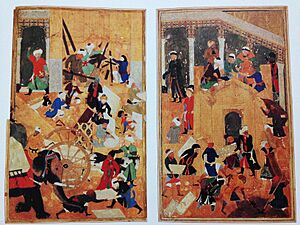
Timur started building the Bibi Khanum Mosque after his military campaign in India. It originally had about 450 marble columns. These were brought and set up with the help of 95 elephants that Timur brought from India. Indian artisans designed the mosque's dome, giving it a unique look.
The most famous landmark in Samarkand is the Gur-e Amir mausoleum. It shows influences from many cultures and religions, especially Islam. Even though the Mongols destroyed much of Samarkand's old Islamic buildings, Timur rebuilt and restored these styles. The mosque's design, with its exact measurements, shows the Islamic love for geometry. The entrance to the Gur-e Amir has beautiful Arabic calligraphy and writings.
Timur paid great attention to details inside the mausoleum. The tiled walls are an amazing example of faience mosaic. This is an Iranian technique where each tile is cut, colored, and placed individually. The tiles in the Gur-e Amir even spell out religious words like "Muhammad" and "Allah."
The walls of the Gur-e Amir also have flower and plant designs, which represent gardens. In Islam, gardens are symbols of paradise. Samarkand itself had two major gardens, which were used for entertaining important guests.
You can also see Turko-Mongol influences in Samarkand's architecture. The melon-shaped domes of the mausoleums are thought to look like yurts, which are traditional Mongol tents. Timur built his tents from stronger materials like bricks and wood.
The colors of buildings in Samarkand have special meanings. Blue is the main color. Timur used blue to show different ideas. For example, the blue shades in the Gur-e Amir represent sadness, as blue was the color of mourning in Central Asia. Blue was also believed to protect against the "evil eye." Also, blue represented water, which was a very rare and valuable resource. So, blue walls showed the city's wealth.
Gold is also very important in the city's buildings. Timur loved grand designs, which explains the large amount of gold used in the Gur-e Amir.
Getting Around Samarkand
Local Transport
Samarkand has a good public transport system. You can find city buses and taxis. Buses are the most common way to get around. Taxis are usually yellow. Since 2017, Samarkand also has tram lines with modern Czech trams. In the past, people also used trolleybuses. You can also find "Marshrutkas," which are small minibuses.
Before 1950, people mostly used horse-drawn carriages and "arabas" (carts pulled by horses or donkeys).
Air Travel
Samarkand International Airport is located north of the city. It opened in the 1930s. Today, you can fly from Samarkand to cities like Tashkent, Moscow, and Istanbul.
Train Travel
Modern Samarkand is an important train hub in Uzbekistan. All major east-west railway lines pass through the city. High-speed trains connect Samarkand with Tashkent and Bukhara. You can also take international trains to cities like Saratov and Astana.
The Russian Empire built the Trans-Caspian Railway in the late 1800s to help expand into Central Asia. Samarkand was the original end point of this railway, and its station opened in 1888.
Samarkand's International Connections
Samarkand is connected with many cities around the world. It is a sister city with:
 Agra, India
Agra, India Balkh, Afghanistan
Balkh, Afghanistan Banda Aceh, Indonesia
Banda Aceh, Indonesia Cusco, Peru
Cusco, Peru Jūrmala, Latvia
Jūrmala, Latvia Kairouan, Tunisia
Kairouan, Tunisia Khujand, Tajikistan
Khujand, Tajikistan Krasnoyarsk, Russia
Krasnoyarsk, Russia Lahore, Pakistan
Lahore, Pakistan Liège, Belgium
Liège, Belgium Mary, Turkmenistan
Mary, Turkmenistan Merv, Turkmenistan
Merv, Turkmenistan Mexico City, Mexico
Mexico City, Mexico New Delhi, India
New Delhi, India Nishapur, Iran
Nishapur, Iran Plovdiv, Bulgaria
Plovdiv, Bulgaria Rio de Janeiro, Brazil
Rio de Janeiro, Brazil Samara, Russia
Samara, Russia Xi'an, China
Xi'an, China Nara, Japan
Nara, Japan
Samarkand also has friendly relations with:
Samarkand in Books
In 2002, Nobel Prize winner Wole Soyinka named his poetry book Samarkand and Other Markets I Have Known.
The English author Jonathan Stroud published his book The Amulet of Samarkand in 2003. The book's story is not about the city itself.
Famous People from Samarkand
- Bakhtiyor Fazilov
- Takhmina Ikromova, an Uzbek rhythmic gymnast
See also
 In Spanish: Samarcanda para niños
In Spanish: Samarcanda para niños


